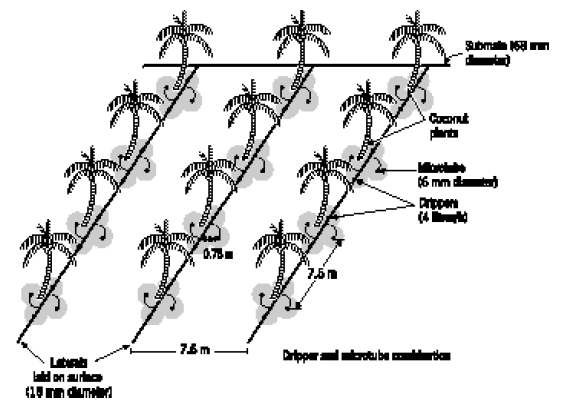Water Technology Center system


During the 1970s, research on drip irrigation was initiated at the Water Technology Centre, College of Agricultural Engineering, Tamil Nadu Agricultural University in Coimbatore, India. As a result of continuous research, extension and feedback from the field, the scientists introduced some economies (e.g. planting two plant rows for each drip line), and durability (e.g. installing the drip tape below the soil surface) in the drip irrigation system elements. Hence, considerable cost reductions can be made in system components and installation, besides increasing the lifespan of the components.
Economic drip irrigation designs, with detailed layout plans, have been proposed for medium- to long-duration crops like cotton, sugarcane, banana, turmeric, coconut and grapes which can save 20–30% of the system cost.
The drip irrigation design can have a surface or sub-surface water delivery system.
When the water delivery system is laid on the surface, the lifespan of the system is reduced by physical and temperature damage. In the sub-surface water delivery system water is delivered to the drip lines using main, submain and laterals laid 80–90 cm below the soil surface. From the lateral, buried in the soil, a micro-tube with a 4-way outlet point is connected to bring the outlet up to the soil surface near the root zone. Since the system components are buried in the soil, the lifespan of the main, submain and laterals can be as long as 13–18 years as compared to 8–10 years under surface installation. Also, cultural operations can be done with the help of tractor- or bullock-drawn implements without damaging the drip system.
In a surface water delivery system for coconut, for example, each plant is provided with 4 drip emitters at 90-degree angles, two drip emitters being fixed on the lateral and the remaining two through micro-tubes.
For irrigating cotton the normal pattern of drip irrigation laterals is laid 75 cm apart in furrows. To reduce the cost of the drip system further, a paired row system can be introduced with 60 cm within the pairs and 90 cm between the pairs thereby reducing the cost of the laterals by 25–30%.
For further information contact Water Technology Centre.
Acknowledgements
- Sijali, Isaya V. DRIP IRRIGATION: Options for smallholder farmers in eastern and southern Africa. RELMA, 2001.
